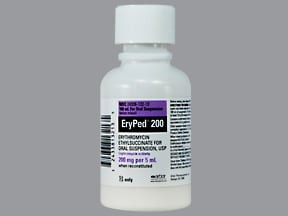
Contents
Eryped
Penicillin is the American Heart Association’s drug of choice for preventing initial attacks of rheumatic fever (treating Streptococcus pyogenes infections of the upper respiratory tract, such as tonsillitis or pharyngitis). Erythromycin is indicated for penicillin-allergic patients. The therapeutic dose should be given for 10 days.
Prevention of Recurrent Attacks of Rheumatic Fever
Penicillin or sulfonamides are the American Heart Association’s drugs of choice for preventing recurrent attacks of rheumatic fever. Erythromycin is recommended for long-term prophylaxis of streptococcal pharyngitis (preventing recurrent attacks of rheumatic fever) in patients allergic to penicillin and sulfonamides.
What are the side effects of Eryped?
The most frequent side effects of oral erythromycin preparations are gastrointestinal and dose-related. They include nausea, vomiting, abdominal pain, diarrhea, and anorexia. Symptoms of hepatitis, hepatic dysfunction, and abnormal liver function test results may occur.
Pseudomembranous colitis symptoms may occur during or after antibiotic treatment.
Erythromycin has been associated with QT prolongation and ventricular arrhythmias, including ventricular tachycardia and torsades de pointes.
Allergic reactions ranging from urticaria to anaphylaxis have occurred. Skin reactions ranging from mild eruptions to erythema multiforme, Stevens-Johnson syndrome, and toxic epidermal necrolysis have been reported rarely.
Rare reports of pancreatitis and convulsions have been reported.
Isolated reports of reversible hearing loss have occurred chiefly in patients with renal insufficiency and receiving high doses of erythromycin.
What is the dosage for Eryped?
Erythromycin ethylsuccinate suspensions and Filmtab tablets can be administered without regard to meals.
Children
Age, weight, and severity of the infection determine the dosage. For mild to moderate infections, the usual dosage for children is 30 to 50 mg/kg/day in equally divided doses every 6 hours. This dosage may be doubled for more severe infections. If twice-a-day dosage is desired, one-half of the total daily dose may be given every 12 hours. Doses may also be given three times daily by administering one-third of the total daily dose every 8 hours.
The following dosage schedule is suggested for mild to moderate infections:
| Body Weight | Total Daily Dose |
| Under 10 lbs | 30-50 mg/kg/day 15-25 mg/kg/q 12 h |
| 10 to 15 lbs | 200 mg |
| 16 to 25 lbs | 400 mg |
| 26 to 50 lbs | 800 mg |
| 51 to 100 lbs | 1200 mg |
| over 100 lbs | 1600 mg |
Adults
400 mg erythromycin ethylsuccinate every 6 hours is the usual dose. Dosage may be increased up to 4 g per day according to the severity of the infection. If twice-a-day dosage is desired, one-half of the total daily dose may be given every 12 hours. Doses may also be given three times daily by administering one-third of the total daily dose every 8 hours.
For adult dosage calculation, use a ratio of 400 mg of erythromycin activity as the ethylsuccinate to 250 mg of erythromycin activity as the stearate, base, or estolate.
In the treatment of streptococcal infections, a therapeutic dosage of erythromycin ethylsuccinate should be given for at least 10 days. In continuous prophylaxis against recurrences of streptococcal infections in persons with a history of rheumatic heart disease, the usual dosage is 400 mg twice a day.
For Treatment of Urethritis Due to C. trachomatis or U. urealyticum
800 mg three times a day for 7 days.
For Treatment of Primary Syphilis
Adults: 48 to 64 g given in divided doses over a period of 10 to 15 days.
For Intestinal Amebiasis
Adults
400 mg four times daily for 10 to 14 days.
Children
30 to 50 mg/kg/day in divided doses for 10 to 14 days.
For Use in Pertussis
Although optimal dosage and duration have not been established, doses of erythromycin utilized in reported clinical studies were 40 to 50 mg/kg/day, given in divided doses for 5 to 14 days.
For Treatment of Legionnaires’ Disease
Although optimal doses have not been established, doses utilized in reported clinical data were those recommended above (1.6 to 4 g daily in divided doses.)
QUESTION
What drugs interact with Eryped?
Erythromycin use in patients receiving high doses of theophylline may be associated with an increase in serum theophylline levels (erythromycin ethylsuccinate) and potential theophylline toxicity. In case of theophylline toxicity and/or elevated serum theophylline levels, the dose of theophylline should be reduced while the patient is receiving concomitant erythromycin therapy.
Hypotension, bradyarrhythmias, and lactic acidosis have been observed in patients receiving concurrent verapamil, belonging to the calcium channel blockers drug class.
Concomitant administration of erythromycin and digoxin has been reported to result in elevated digoxin serum levels (erythromycin ethylsuccinate).
There have been reports of increased anticoagulant effects when erythromycin and oral anticoagulants were used concomitantly. Increased anticoagulation effects due to interactions of erythromycin with various oral anticoagulants may be more pronounced in the elderly.
Erythromycin is a substrate and inhibitor of the 3A isoform subfamily of the cytochrome p450 enzyme system (CYP3A). Coadministration of erythromycin and a drug primarily metabolized by CYP3A may result in elevated drug concentrations. Interactions with other drugs metabolized by the CYP3A isoform are also possible. The following CYP3A based drug interactions have been observed with erythromycin products in post-marketing experience:
Ergotamine/dihydroergotamine
Concurrent use of erythromycin and ergotamine or dihydroergotamine has been associated with acute ergot toxicity characterized by severe peripheral vasospasm and dysesthesia.
Erythromycin has been reported to decrease the clearance of triazolam and midazolam, and thus, may increase the pharmacologic effect of these benzodiazepines.
HMG-CoA Reductase Inhibitors
Erythromycin has been reported to increase concentrations of HMG-CoA reductase inhibitors (such as lovastatin and simvastatin). Rare reports of rhabdomyolysis have been reported in patients taking these drugs concomitantly.
Sildenafil (Viagra)
Erythromycin has been reported to increase the systemic exposure (AUC) of sildenafil. Reduction of sildenafil dosage should be considered. (See Viagra package insert.)
There have been spontaneous or published reports of CYP3A based interactions of erythromycin with cyclosporine, carbamazepine, tacrolimus, alfentanil, disopyramide, rifabutin, quinidine, methylprednisolone, cilostazol, vinblastine, and bromocriptine.
Concomitant administration of erythromycin with cisapride, pimozide, astemizole, or terfenadine is contraindicated.
In addition, there have been reports of interactions of erythromycin with drugs not thought to be metabolized by CYP3A, including hexobarbital, phenytoin, and valproate.
Erythromycin has been reported to significantly alter the metabolism of the nonsedating antihistamines terfenadine and astemizole when taken concomitantly. Rare cases of serious cardiovascular adverse events, including electrocardiographic QT/QTc interval prolongation, cardiac arrest, torsades de pointes, and other ventricular arrhythmias have been observed. In addition, deaths have been reported rarely with concomitant administration of terfenadine and erythromycin.
There have been post-marketing reports of drug interactions when erythromycin is co-administered with cisapride, resulting in QT prolongation, cardiac arrhythmias, ventricular tachycardia, ventricular fibrillation, and torsades de pointes, most likely due to inhibition of hepatic metabolism of cisapride by erythromycin. Fatalities have been reported.
Drug/Laboratory Test Interactions
Erythromycin interferes with the fluorometric determination of urinary catecholamines.
Is Eryped safe to take while pregnant or breastfeeding?
There is no evidence of teratogenicity or adverse effects on reproduction in female rats fed erythromycin base prior to and during mating, gestation, and through weaning. No evidence of teratogenicity or embryotoxicity was observed when erythromycin base was given to pregnant rats and mice and pregnant rabbits. Erythromycin is excreted in human milk. Caution should be exercised when erythromycin is administered to a nursing woman.
Summary
Eryped (erythromycin ethylsuccinate) is an antibiotic that treats bacterial infections of the lungs, skin, intestinal and urinary tracts, among others. It is not effective against viral infections and should not be used for general infection prevention in most cases to avoid promoting antibiotic resistance.


